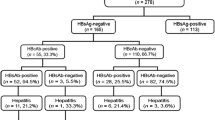Abstract
The association of prolonged rituximab therapy and hepatitis B virus (HBV) reactivation in diffuse large B-cell lymphoma (DLBCL) and the role of lamivudine prophylaxis remain undefined. The prevalence and mortality of HBV reactivation in HBsAg-positive patients with DLBCL undergoing rituximab-based treatment, who received prophylactic treatment with or without lamivudine, were retrospectively analyzed. From January 2003 to December 2009, there were 50 patients enrolled in the study, among of which 30 received the prophylactic treatment of lamivudine and 20 without prophylactic treatment of lamivudine. Among of the 50 patients, seven patients received further rituximab maintenance, once every 3 months for 2 years. Compared with lamivudine treatment group, it showed that there was significantly higher prevalence of HBV reactivation (60.0% vs 13.3%, P = .001), severe hepatitis (45.0% vs 6.7%, P = .004), and mortality (25.0% vs 3.3%, P = .032) in non-lamivudine prophylactic group; however, there was no statistically significant difference in the HBV DNA levels at reactivation (3.94 × 106 vs 8.30 × 105 copies/ml, P = .47) and the time from first dose of rituximab to HBV reactivation(207 vs 386 days, P = .28). For patients undergoing further rituximab maintanence treatment, the prevalence and mortality of HBV reactivation were 71.4 and 28.6%, respectively. The prevalence and mortality of HBV reactivation are 66.7% vs 75.0% (P = 1.00) and 0 vs 50.0% (P = .43) in lamivudine prophylactic and non-lamivudine prophylactic groups, respectively. The effect of lamivudine prophylaxis on preventing HBV reactivation was found to be less in patients undergoing longer duration of rituximab treatment. A longer duration of rituximab treatment contributed to higher morbidity and mortality of HBV reactivation in HbsAg-positive patients with DLBCL. Further study is warranted for the optimal management of hepatitis caused by HBV reactivation
Similar content being viewed by others
References
Ganem D, Prince AM. Hepatitis B virus infection: natural history and clinical consequences. N Engl J Med. 2004;350:1118–29.
Lok AS, McMahon BJ. Chronic hepatitis B. Hepatology. 2007;45:507–39.
Lok ASF, Lai CL, Wu PC. Hepatitis B virus infection in Chinese families in Hong Kong. Am J Epidemiol. 1987;126:492–9.
Liang RH, Lok AS, Lai CL, Chan TK, Todd D, Chiu EK. Hepatitis B infection in patients with lymphomas. Hematol Oncol. 1990;8:261–70.
Coiffier B, Lepage E, Brière J, et al. CHOP chemotherapy plus rituximab compared with CHOP alone in elderly patients with diffuse large-B-cell lymphoma. N Engl J Med. 2002;346:235–42.
Habermann TM, Weller EA, Morrison VA, et al. Rituximab-CHOP versus CHOP alone or with maintenance rituximab in older patients with diffuse large B-cell lymphoma. J Clin Oncol. 2006;24:3121–7.
Dai M-S, Chao T-Y, Kao W-Y, Shyu R-Y, Liu T-M. Delayed hepatitis B virus reactivation after cessation of preemptive lamivudine in lymphoma patients treated with rituximab plus CHOP. Ann Hematol. 2004;83:769–74.
Westhoff TH, Jochimsen F, Schmittel A, et al. Fatal hepatitis B virus reactivation by an escape mutant following rituximab therapy. Blood. 2003;102:1930.
Hsu C, Hsiung CA, Su IJ, et al. A revisitof prophylactic lamivudine for chemotherapy-associated hepatitis B reactivation in non-Hodgkin’s lymphoma: a randomized trial. Hepatology. 2008;47:844–53.
Yeo W, Johnson PJ. Diagnosis, prevention and management of hepatitis B virus reactivation during anticancer therapy. Hepatology. 2006;43:209–20.
van der Kolk LE, Baars JW, Prins MH, van Oers MHJ. Rituximab treatment results in impaired secondaryhumoral immune responsiveness. Blood. 2002;100:2257–9.
Lazdina U, Alheim M, Nyström J, et al. Priming of cytotoxic T cell responses to exogenous hepatitis B virus core antigen is B cell dependent. J Gen Virol. 2003;84:139–46.
Liao CA, Lee CM, Wu HC, Wang MC, Lu SN, Eng HL. Lamivudine for the treatment of hepatitis B virus reactivation following chemotherapy for non-Hodgkin’s lymphoma. Br J Haematol. 2002;116:166–9.
Pei SN, Chen CH, Lee CM, et al. Reactivation of hepatitis B virus following rituximab-based regimens: a serious complication in both HBsAg-positive and HBsAg-negative patients. Ann Hematol. 2010;89(3):255–62.
He Y-F, Li Y-H, Wang F-H, et al. The effectiveness of lamivudine in preventing hepatitis B viral reactivation in rituximab-containing regimen for lymphoma. Ann Hematol. 2008;87:481–5.
Bartholomeusz A, Locarnini SA. Antiviral drug resistance. Clinical consequences and molecular aspects. Semin Liver Dis. 2006;26:162–70.
Chang TT, Lai CL, Kew YS, et al. Entecavir treatment for up to 5 years in patients with hepatitis B e antigen-positive chronic hepatitis B. Hepatology. 2010;51:422–30.
Lok AS, McMahon BJ. Chronic hepatitis B: update 2009. Hepatology. 2009;50(3):661–2.
Garcia-Rodriguez MJ, Canales MA, Hernandez-Maraver D, Hernandez-Navarro F. Late reactivation of resolved hepatitis B virus infection: an increasing complication post rituximab based regimens treatment. Am J Hematol. 2008;83:673–5.
McLaughlin P, Grillo-Lopez AJ, BK Link, et al. Rituximab chimeric anti-CD20 monoclonal antibody therapy for relapsed indolent lymphoma: half of patients respond to a four-dose treatment program. J Clin Oncol. 1998;16:2825–33.
Yeo W, Chan TC, Leung NWY, et al. Hepatitis B virus reactivation in lymphoma patients with prior resolved hepatitis B undergoing anticancer therapy with or without rituximab. J Clin Oncol. 2009;27:605–11.
Conflict of interest
None declared.
Author information
Authors and Affiliations
Corresponding author
Additional information
Xiao-Qin Chen and Jie-Wen Peng contributed equally to this work.
Rights and permissions
About this article
Cite this article
Chen, XQ., Peng, JW., Lin, GN. et al. The effect of prophylactic lamivudine on hepatitis B virus reactivation in HBsAg-positive patients with diffuse large B-cell lymphoma undergoing prolonged rituximab therapy. Med Oncol 29, 1237–1241 (2012). https://doi.org/10.1007/s12032-011-9974-0
Received:
Accepted:
Published:
Issue Date:
DOI: https://doi.org/10.1007/s12032-011-9974-0




